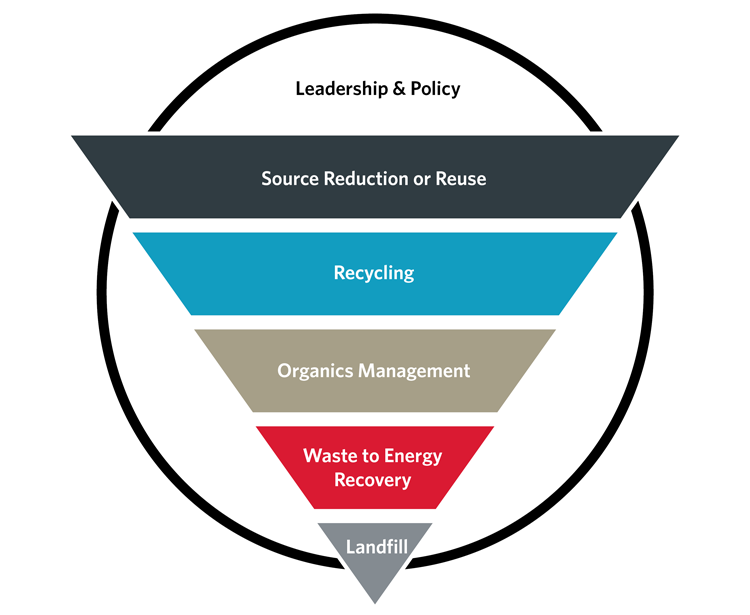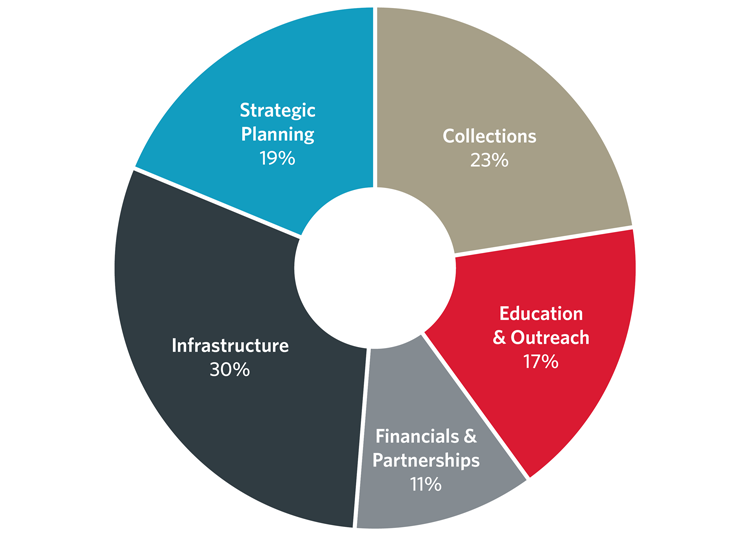Climate Action and Solid Waste Policy Intersect For a Circular Economy
Organics Management Opportunities Stand Out in North American Climate Action Plan Research
The alignment of climate action and solid waste policy has sparked a pivotal moment in solid waste management: a fundamental shift towards a circular economy and examining pathways for solid waste that bring together innovative and traditional approaches.
We researched North American climate action plans spanning 15 cities and five counties, and discovered the plans reinforced the critical role organics management plays in climate resiliency and decarbonization.
More than 300 waste-related climate actions were identified. A quarter of them focused on organics management.
Waste Climate Actions in the Waste Management Hierarchy
No single solid waste solution can address every goal set forth by the climate action plans – it takes an integrated approach. We categorized the findings in alignment with the U.S. Environmental Protection Agency waste management hierarchy, adding an overarching category for leadership and policy.

The climate action plans reveal waste planners may find opportunity when organics management focuses on achieving measurable benefits related to community sustainability goals. Compost and digestate offer such benefits from carbon sequestration and soil improvements.
The plans also acknowledge, directly or indirectly, that carbon emissions from solid waste operations can be deceiving. While direct emissions generally represent a small percentage of a community’s greenhouse gas inventory, indirect or consumption-based emissions, including the embodied carbon within discarded materials, are the largest source.
Surprisingly, waste planners and solid waste facility owners were not part of the climate action planning process in many of the plans researched. Elements of waste diversion were often raised by stakeholders, climate planners and policymakers.
6 Categories Break Down Organics Management Opportunity from 20 Climate Action Plans
We organized our findings into six categories: strategic planning, finance and partnerships, collections, infrastructure, and education and outreach.

Strategic Planning [Comprises 19% of Organics Climate Actions]
Strategic planning encompasses many of the big-picture planning efforts with a focus on using policies to support planning efforts and ordinances. Several plans leveraged the existing U.S. EPA food management hierarchy and are creating new policies around it.
Finance and Partnerships [Comprises 11% of Organics Climate Actions]
Our research considered everything from public-to-public and public-to-private along every part of the organics stream. While fewer strategies were related to financing and partnerships, the plans recognized the importance of unique partnerships to address organics, like setting up joint infrastructure or pooling end products from organics/composting/materials.
Climate Action Plan Feature: Kansas City’s bi-state Mid-America Regional Council Climate Action Plan focused on food systems, including a plan to reduce food waste and loss. They developed a strategy to partner with local specifiers and composters to expand markets for compost products, understanding that if compost is created, an end-use plan needs to be in place.
HDR Case Study, Food Diversion for the City and County of Sacramento, California: To optimize economies of scale, the city and county of Sacramento and city of Folsom came together in a financial partnership to comply with California’s Senate Bill 1383, which requires 75% food diversion by 2025. Together, they procured nearly a quarter-million tons of organic material annually. The procurement attracted six respondents that offered four facilities focused on anaerobic digestion for composting. We assisted the jurisdictions by evaluating fees, financial implications, environmental permitting and transportation needs. By combining material quantities and working together, the three jurisdictions were able to attract a more robust response.
Collections [Comprises 23% of Organics Climate Actions]
Representing nearly a quarter of organics strategies, the term “collections” applies to all steps of organics management. As plans dove into evaluating, developing, implementing, expanding or mandating collection programs, a collection program for food was specifically mentioned seven times, with yard waste coming in at four. Plans also included curbside and drop-off collection programs, and while both have potential to divert waste and reduce climate impacts, the real question is how to collect the materials.
Climate Action Plan Feature: Portland, Oregon, uses a combination of mandatory collections from commercial waste generators and voluntary efforts from multifamily and residential customers.
HDR Case Study, City of Sunnyvale, California, Collection System: Highly effective collections programs like the city of Sunnyvale, California, holistically consider demographics, population density and budget. Collections are addressed as part of the city’s climate action plan with an approach focused on isolating materials and educating Sunnyvale residents on successfully using the city’s three-bin collection system for five separate material streams.
- Recycling: A grey recycling bin is split into two sections, one for fibers and the other for containers. This separates materials for a dual-stream recycling facility which processes cardboard and paper into a high-quality fiber, and the containers which separate glass and film plastics for downstream processing and use as commodity to offset collections cost.
- Yard waste: A green bin is exclusively used to gather yard waste, capturing green materials that meet OMRI Listed® organics requirements. Well-sorted yard waste captures some of the highest value as a downstream commodity.
- Trash and food waste: A black bin captures trash on one side and post-consumer food waste — meat, vegetables, dairy, eggs and some film plastics — on the other side. The food waste is processed to produce a mash used as animal feed for a nearby feedlot, and high-quality material for anaerobic digestion.
Accomplishing a citywide diversion rate of more than 65%, this three-bin, five-commodity, source-separated collection program optimally uses each commodity.
Infrastructure [Comprises 30% of Organics Climate Actions]
Infrastructure stands out with the greatest number of organics climate actions. Our research found that six of the 20 plans researched called out the need for anaerobic digestion for foodways in particulate management, and 16 categories identified compost as the alternative for managing those materials. Half of the plans identified a need for local markets focused on city and county use of finished compost. Many questions arose from the infrastructural opportunities. Namely, what comes first? Is it program implementation, or infrastructure? We worked through these questions with the city of Surrey, British Columbia.
HDR Case Study, Organics to Biofuel Facility Supplies Transportation Fleet in City of Surrey, British Columbia: Located east of Vancouver, Surrey is the fastest-growing city in the area. To accommodate a growing population, Surrey took on a biofuel infrastructure project that became a model of circular economy. The Surrey Biofuel Facility is the first closed-loop organic waste facility in North America.
Surrey determined it had 80,000 tons of organic material per year that could be dedicated to a new organics processing facility. We used a market-sounding exercise to determine a facility size of 110,000 tons per year would be ideal for economies of scale. Procurement requested that prospective vendors secure the additional 30,000 tons per year to make the project financial terms attractive. Up to a quarter of the project’s funding was supplied by P3 Canada, a federal entity, with the remainder from the city.
Proposals offered a combination anaerobic digestion and composting technologies. The facility selected converts organic materials into a biogas that is refined into compressed natural gas, a biofuel used to operate Surrey’s transportation fleet.
Over the course of a year, the city educated the public about how to use a co-collected yard/food waste system. Findings from monthly waste characterization studies were used to refine messaging to the public in order to reduce contamination.
Today, 100% of organic waste collected at the Surrey Biofuel Facility is recovered and converted into renewable natural gas or compost.
Education and Outreach [Comprises 17% of Organics Climate Actions]
Different types of education and outreach are necessary to reach every type of organics generators. Climate action plans included a residential focus looking at community events, and a business lens for commercial participation. Plans also called out the need for incentive programs, to address the challenge of motivating residents to engage.
Climate Action Plan Feature: The climate action plan in Ann Arbor, Michigan, focused on home composting education and outreach designed to help residents identify organic materials and how to manage them.
Why now? Opportunity Arises for Solid Waste Management
Public interest in climate-related opportunities is intensifying, and it’s opening the door to shared programming and education. The researched climate action plans indicate that climate and solid waste programming are strategic components of a solution.
Add expanding federal funding opportunities, and we’re in an unprecedented time of growth and program expansion. Grants are available from the U.S. Environmental Protection Agency to support infrastructure and education, and from the U.S. Department of Agriculture for composting and new program startups.
A Unified Response from Solid Waste Managers and Climate Action Planners
The conversational language between climate action plans and solid waste management plans isn’t always the same — alignment could help. In climate action plans, organics management is contextually defined as food waste, green waste and yard waste from residential and commercial sources. The plans often refer to material that's ready for processing. In solid waste management, that definition typically includes packaging as well. To identify cohesive programming, there’s opportunity for climate action planners and solid waste managers to come together.
It will take the dedication and creativity of many disciplines and departments to achieve goals set forth in these ambitious climate action plans. Our research identified opportunities to take a comprehensive approach to strategic planning, integrate outside-the-box outreach and education, and develop engaging collections opportunities, innovative infrastructure, and creative partnerships and strategic financing approaches.
In order to achieve the goals set forth in climate action plans, it’s critical for local governments to think through collection methods and related education that can modify behaviors and induce change. It’s also vital to consider the value of high-quality downstream byproducts, and in turn, attract downstream facilities to accommodate the byproducts. There’s a need to identify partnerships — economies of scale is important. Where multiple entities can come together to achieve higher quality, create a better product, gather more material or access innovative financing options, greater outcomes can be achieved.
It’s an exciting time to be a waste planner. Communities across North America see the opportunity to embrace elements of a circular economy and take holistic, measurable steps toward managing waste as part of an impactful climate action plan.





